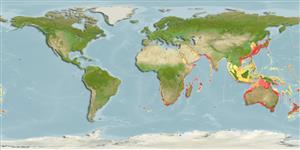Пластиножаберные (акулы и скаты) (sharks and rays) >
Myliobatiformes (Stingrays) >
Dasyatidae (Stingrays) > Dasyatinae
Etymology:
Environment: milieu / climate zone / depth range / distribution range
экология
морской; солоноватоводный демерсальный; пределы глубины 0 - 476 m (Ref. 5578), usually 0 - 200 m (Ref. 89422). Temperate
Indo-West Pacific: antitropical; from southern Africa to New Zealand, and off Japan and Peter the Great Bay (eastern Russia).
Length at first maturity / Size / Вес / Возраст
Maturity: Lm ?, range 120 - ? cm
Max length : 430 cm TL самец/пол неопределен; (Ref. 5578); common length : 125 cm TL самец/пол неопределен; (Ref. 9258)
Краткое описание
морфология | морфометрия
колючие лучи спинного плавника (общее число): 0; членистые (мягкие) лучи спинного плавника (общее число): 0. This species is huge, plain-coloured, with a disc broad and rhombic, belly with transverse groove, tail short tapering strongly before caudal sting, thorns when present are confined to tail before sting, pectoral fin with an oblique rows of white spots dorsally; disc width ca. 1.1-1.2 times its length, very thick trunk; narrowly-rounded pectoral-fin apex; short snout, obtuse with tip barely extended and anterior margins weakly convex; small eyes with orbit length and spiracle 2.0-2.2 in snout length; broad interorbital space, up to 4 times orbit length in adults; mouth often with 5-7 oral papillae, deep labial furrows, weakly convex lower jaw; very broadly skirt-shaped nasal curtain, its margin fringed; oblique oval nostrils; smooth skin, no derml denticles, with specimens > 45 cm WD having a row of spear-shaped or starry-based thorns and tubercles on mid-line of tail before the caudal sting and the tail beyond this is covered with sharp thornlets; very broad tail depressed at the base, often shorter that width disc, often with one caudal sting, its ventral fold is short but prominent (extending to just beyond tip of sting), its dorsal fold reduced to a hard ridge; pelvic fins are rather small with narrowly-rounded apices. Colour of upper surface uniformly greyish brown and darkest on tail tip and above the eye; white inside of spiracles, pores around side of head and diagonal row of pores on each side of anterior disc; white ventrally; disc margin and undersurface of tail dusky (Ref. 114953).
Occurs offshore, on the outer shelf and uppermost slope; sometimes close inshore (Ref. 5578), in very shallow ( 0 m) depths (Ref. 26346). Found on sandy bottoms, in bays, harbors, and near rocky reefs (Ref. 12951). Often in aggregations (Ref. 12951). Feeds on fishes, bivalves, squid, and crustaceans (Ref. 12951). Ovoviviparous (Ref. 50449). Reputed to be the largest stingray in the world weighing more than 350,000 g (Ref. 6871). Frequently raises its tail in a scorpion-like fashion when approached, but is considered more as inquisitive rather than aggressive (Ref. 6871). The barbed tail however can inflict a severe or potentially fatal wound (Ref. 6871). Sometimes caught by anglers (Ref. 5578). It is parasitised by the monogenean Heterocotyle tokoloshei in the gills (Ref. 124053)
Life cycle and mating behavior
половая зрелость | размножение | нерест | икра | Fecundity | личинки
Exhibit ovoviparity (aplacental viviparity), with embryos feeding initially on yolk, then receiving additional nourishment from the mother by indirect absorption of uterine fluid enriched with mucus, fat or protein through specialised structures (Ref. 50449). Distinct pairing with embrace (Ref. 205). During courtship, the male will hold onto the pectoral margin of a female (sometimes for hours) as she swims through the water. The male flips under the female and inserts a clasper. The male beats his tail from side to side to move the clasper backward and forward in the cloca. Copulation lasts 3-5 minutes. Males have been observed to nudge the female's abdomen during parturition. Viviparous, young born at about 36 cm WD (Ref. 6871).
Last, P.R., W.T. White, M.R. de Carvalho, B. Séret, M.F.W. Stehmann and G.J.P. Naylor, 2016. Rays of the world. CSIRO Publishing, Comstock Publishing Associates. i-ix + 1-790. (Ref. 114953)
Статус Красного Списка МСОП (Ref. 130435)
Использование человеком
объект спортивного рыболовства: да; аквариум: коммерческий
дополнительная информация
Возраст/РазмерыростЗависимость между длиной и массой телаЗависимость между длинамиРазмерный составморфометрияморфологияличинкидинамика численности личинокпополнениечисленностьBRUVS
ссылкиаквакультура (рыбоводство)особенности рыбоводствастепень растяжениягенетикаElectrophoresesнаследуемостьболезниобработкаNutrientsMass conversion
инструменты
Специальные отчеты
Скачать в формате XML
ресурсы в Интернет
Estimates based on models
Preferred temperature (Ref.
123201): 14.6 - 28.5, mean 24.1 °C (based on 2002 cells).
Phylogenetic diversity index (Ref.
82804): PD
50 = 0.6250 [Uniqueness, from 0.5 = low to 2.0 = high].
Bayesian length-weight: a=0.00646 (0.00265 - 0.01571), b=3.06 (2.86 - 3.26), in cm total length, based on LWR estimates for this (Sub)family-body shape (Ref.
93245).
Trophic level (Ref.
69278): 3.9 ±0.45 se; based on food items.
Fishing Vulnerability (Ref.
59153): Very high vulnerability (90 of 100).
Nutrients (Ref.
124155): Calcium = 2.46 [0.37, 44.68] mg/100g; Iron = 0.194 [0.018, 2.273] mg/100g; Protein = 21.3 [18.7, 24.0] %; Omega3 = 0.362 [0.114, 1.026] g/100g; Selenium = 21.7 [4.4, 114.2] μg/100g; VitaminA = 1.89 [0.16, 20.28] μg/100g; Zinc = 0.26 [0.02, 2.86] mg/100g (wet weight);
